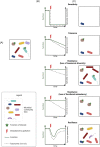Unlocking secrets of microbial ecotoxicology: recent achievements and future challenges
- PMID: 37669892
- PMCID: PMC10516372
- DOI: 10.1093/femsec/fiad102
Unlocking secrets of microbial ecotoxicology: recent achievements and future challenges
Erratum in
-
Correction to: Unlocking secrets of microbial ecotoxicology: recent achievements and future challenges.FEMS Microbiol Ecol. 2023 Oct 17;99(11):fiad135. doi: 10.1093/femsec/fiad135. FEMS Microbiol Ecol. 2023. PMID: 37935577 Free PMC article. No abstract available.
Abstract
Environmental pollution is one of the main challenges faced by humanity. By their ubiquity and vast range of metabolic capabilities, microorganisms are affected by pollution with consequences on their host organisms and on the functioning of their environment. They also play key roles in the fate of pollutants through the degradation, transformation, and transfer of organic or inorganic compounds. Thus, they are crucial for the development of nature-based solutions to reduce pollution and of bio-based solutions for environmental risk assessment of chemicals. At the intersection between microbial ecology, toxicology, and biogeochemistry, microbial ecotoxicology is a fast-expanding research area aiming to decipher the interactions between pollutants and microorganisms. This perspective paper gives an overview of the main research challenges identified by the Ecotoxicomic network within the emerging One Health framework and in the light of ongoing interest in biological approaches to environmental remediation and of the current state of the art in microbial ecology. We highlight prevailing knowledge gaps and pitfalls in exploring complex interactions among microorganisms and their environment in the context of chemical pollution and pinpoint areas of research where future efforts are needed.
Keywords: diversity; ecosystem functions; holobiont; microorganisms; nature-based solutions; pollution.
© The Author(s) 2023. Published by Oxford University Press on behalf of FEMS.
Conflict of interest statement
The authors declare no competing interests.
Figures






References
-
- Adams GO, Fufeyin PT, Okoro SEet al. . Bioremediation, biostimulation and bioaugmention: a review. Int J Environ Bioremediat Biodegrad. 2015;3:28–39.. 10.12691/ijebb-3-1-5. - DOI
-
- Adrian L, Löffler FE. Organohalide-respiring bacteria—an introduction. In: Adrian L, Löffler FE, (eds), Organohalide-Respiring Bacteria. Berlin, Heidelberg: Springer, 2016, 3–6.. 10.1007/978-3-662-49875-0_1. - DOI
-
- Ahemad M, Khan MS. Comparative toxicity of selected insecticides to pea plants and growth promotion in response to insecticide-tolerant and plant growth promoting Rhizobium leguminosarum. Crop Prot. 2010;29:325–9.. 10.1016/j.cropro.2010.01.005. - DOI

